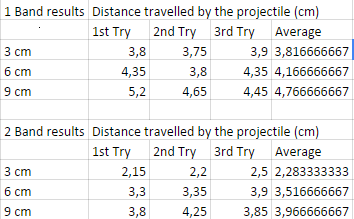Motion in Air Investigation
Background research
There are four main forces that affect the flight of an object through air; weight, lift, thrust and drag.
Weight is the force of gravity. It acts in a downward direction—toward the center of the Earth.
Lift is the force that acts at a right angle to the direction of motion through the air. Lift is created by differences in air pressure.
Thrust is the force that propels a flying machine in the direction of motion. Engines produce thrust.
Drag is the force that acts opposite to the direction of motion. Drag is caused by friction and differences in air pressure.
Equations related:
(Astronomyonline.org, 2015)
(Cloudlearn.co.uk, 2015)
(Ffwdwheels.com, 2015)
Research question
“How does changing the force which a projectile is shot affect the distance of the flight of a projectile?”
My experiment consist in create a projectile shooter with rubber bands and change the force that the projectiles are shot by using more force in the rubber band like stretching more the rubber band or using more that one rubber band.
Hypothesis
My hypothesis is that when the rubber band will be more stretched, more force will be used to shot the projectile, making the projectile fly more and traverse more distance because using more force to shot a projectile makes that more force is passed into the projectile and making the projectile be shot stronger.
Variables
Independent – I will change the force that the projectile is shot by stretching more the rubber band and also changing the number of rubber bands. I will measure the stretching by the distance of the rubber band stretched from its static point,.
Dependent – The distance that the projectile traverse and I will measure the distance in meters.
Control – The gravity that pulls the projectile to the floor. For changing this force we have to go to another planet or go a lot higher when the gravity is a little less stronger.
List of materials
- Rubber bands
- 2 Pens
- Plasticene
- Ruler
- Paper
Method
- Make a projectile shooter
- Make 2 plasticene bases
- Stick the 2 pens into a plasticene base
- Put a rubber band across the two pens
- Put the other plasticene base in the other part of the pen
- Make a projectile out of paper
- Shoot the projectile with the P.S. with the rubber band at 3 cm, 6 cm and 9 cm stretched.
- Repeat N.3 two more times
- Put two rubber bands instead of one and repeat N.3 and N.4
- Collect all the data into a table
Table of Results
Graph
In this lab experiment I have change two variables: the stretching of the rubber band with the force and the number of rubber bands used. My hypothesis about the first variable was correct because in the results are shown that with more distance the rubber band is stretched, the more distance the projectile travelled. Like the formulas that I had collected before, if the acceleration of the projectile is higher, also the intial velocity will be higher and the projectile will reach a higher velocity and it will travel a higher distance.
My hypothesis about the second variable, changing the number of rubber band for give a bigger acceleration, in theory was correct because if more force is applied to the projectile at the start, the more acceleration it will have and with two rubbers bands you apply more force than with a rubber band. But in reality the hypothesis is wrong because the force that is applied with the rubber band is related with the elasticity and the shape of the rubber band. If you use a smaller elastic band, its logical that you can´t stretch the same as a bigger rubber band and because of that, the smaller rubber band gets before into a point when it is completely stretched and in that moment is when the rubber band unleash all the force to restore its original form, making the projectile travel more distance and in conclusion, making more distance than two rubbers band at stretching the rubber band at less stretching.
Evaluation
The main problems that my experiment had was: the angle of projection, the shape of the projectile and the measuring of the force applied to the projectile.
The problem with the angle of projection was that when I shot the projectile, it was difficult to to shoot it as the other times because it did not had been shooted with the same angle and with the same distance because the rubber band was not keeping on the same shape. The solution to this problem is to shot the projectiles with a machine that is programmed to shot always the same. Also another solution is to always shoot the projectile with the projectile on the floor because if it is always shot on the floor, the angle of projection will be the same.
The problem with the shape of the projectile was that the method do not show a specific way to make the projectile and in consequence, the projectiles made could vary in air resistance, weight, etc... The solution to this problem is to use as projectile a marble with a certain diameter, making all the projectiles had the same properties or very similar.
The problem with measuring the force applied to the projectile is that i had no method to control the force that was transfered to the projectile making them travel more or less distance depernding on the force that is used on them. The solution to this problem is to use a radar of velocity to calcule the velocity of the projectile and, by the ecuations show above, calcule the force that it was transfered to the projectile through the rubber band
References
Astronomyonline.org,. (2015). Retrieved 9 June 2015, from http://astronomyonline.org/Science/Images/Mathematics/Force1.gif
Ffwdwheels.com,. (2015). Retrieved 9 June 2015, from http://www.ffwdwheels.com/assets/FAQ/faq-wvsa-2.jpg
Cloudlearn.co.uk,. (2015). Retrieved 9 June 2015, from http://cloudlearn.co.uk/wp-content/uploads/2013/08/physics-acceleration.jpg


